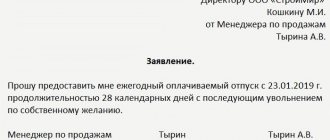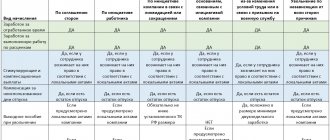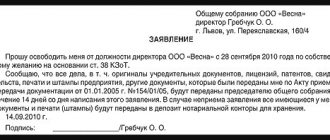How to go on another vacation and quit immediately after it: Art. 127 Labor Code of the Russian Federation
Vacation followed by dismissal is a phrase used in labor legislation as a separate concept.
IMPORTANT! In accordance with Art. 127 of the Labor Code of the Russian Federation, an employee has the right to leave before dismissal (except for dismissal for guilty actions).
This double maneuver by the employee entails additional steps for the employer to formalize and implement it. Each component of the furlough-furlough scheme requires compliance with legal requirements.
For example, dismissal is a whole complex of events, the initial step of which is the employee writing a statement. It launches a mechanism for interaction between management, personnel officers, accountants and other specialists of the company. Each of the listed “cogs” of the internal company apparatus performs its own function, the result of which will be the dismissal of the employee, formalized in accordance with the law.
At the same time, the interests of both parties to the terminated employment contract should not be affected - the employee will receive the money due to him, and the employer will fulfill the functions assigned to him in complying with the dismissal procedure.
“Unified Form No. T-8 - form and sample of completion” will help you fill out an order in connection with the termination of an employment relationship .
No less important in terms of compliance with legally established procedures is the process of an employee going on leave.
This material will help you understand the specifics of issuing a “vacation” order. .
And combining these events into one requires an even more careful and scrupulous approach, since it contains a number of mandatory legal requirements.
ConsultantPlus experts explained whether it is possible to provide a worker with leave at his own expense followed by dismissal. Get free trial access to the system and move on to the Ready-made solution.
Application - the starting point for registration
The set of measures to formalize the “vacation-dismissal” procedure begins with an application from the employee. The employee writes it in his own hand in a generally accepted form addressed to the head of the company, indicating his position and surname. There is no special form for such a statement, and there are no restrictions on its volume and content.
Since a double event is planned (vacation - dismissal), there can also be 2 applications. The first will contain a request for leave with a special clause regarding its duration and starting date. The second statement will contain a written desire to sever the employment relationship with the employer.
There is no restriction on the number of statements in the law, so it is possible that the employee will combine the texts of both statements into one document.
If an employee decides to leave immediately after the vacation due to him according to the approved vacation schedule, then a separate application for vacation does not need to be written, since the schedule is already the basis for receiving vacation.
Applications can be made on our website.
Example
Timofeev N.L., an auxiliary worker in the mechanical section, decided to quit, having previously taken his legally earned regular vacation. He considered fiddling with individual applications to be an unnecessary waste of time and effort, so he expressed his will in one phrase: “I ask you to allow me to go on vacation from April 16, 2021 for 28 calendar days, followed by dismissal of my own free will.”
We will tell you how to apply for leave followed by dismissal in the following sections.
Statement
If an employee plans to take a vacation and then resign, then he needs to submit two applications: for vacation and dismissal. However, it is established at the legislative level that the text of both statements can be included in one.
The document itself can be drawn up either in printed or handwritten form. In the second case, you need to use a pen with black or blue ink. The unified form of the document is not approved at the legislative level, which allows the employee to draw it up in any form or use a specially designed form issued by the company’s HR department. The main requirement for the application is the complete absence of errors. It requires information to be reflected:
- on the exact name of the organization, as well as the position and full name of the person in whose name the application is being submitted;
- about the position and full name of the employee who plans to resign;
- about the title of the document – “Application”;
- about an employee's request. This paragraph requires you to reflect the desired start date of the vacation, the exact number of calendar days, as well as a request to terminate the employment relationship.
Sample application for leave followed by voluntary dismissal
It is important to know! The employee, at his own discretion, can take all the vacation days required by law (under normal conditions - 28 calendar days) or divide it into 2 parts: the first - to rest, the second - to receive a cash payment.
At the end, you must indicate the date the document was drawn up, the applicant’s signature with a transcript.
The application must be submitted to the HR department or manager. This can be done in person or by registered letter with notification. The document must be submitted 14 days before the desired start date of the vacation.
After reading and signing the application, the manager must issue an order to grant leave, and at the end of it, an order to terminate the employment relationship in the T-8 form. The date of the dismissal order may coincide with the date of dismissal.
Sample order for voluntary dismissal
It is important to know! Even if an employee has taken parental leave rather than annual leave, he can resign on the last day of rest. At the same time, the employee has the opportunity to withdraw the application and continue his work activity in his previous position without any consequences.
We respect rights and take into account restrictions
In order for the procedure for going on leave with subsequent dismissal to be carried out within the framework of labor legislation, the employer and employee must not forget about their rights, responsibilities and restrictions.
Example (continued)
Timofeev N.L., an auxiliary worker at the mechanical section, was refused his desire to go on vacation before his dismissal, and his attempts to complain to the labor inspectorate about his employer were unsuccessful. In this situation, the employer’s consent or refusal is his right, not his obligation, in accordance with the determination of the Constitutional Court of the Russian Federation dated 02/05/2004 No. 29-O.
If the director of the company changes his mind and allows Timofeev N.L. to go on vacation before resigning, Timofeev N.L. has a chance to change his mind and not sever the employment relationship.
There is one exception to this rule: it will not be possible to refuse leave before dismissal if a clause on the provision of leave before dismissal is present in the agreement between the employee and the company (employment contract).
Legislation allows an employee to express his desire to return to his workplace after a vacation, but there is a time limit for such a step: he can change his mind only before going on vacation (letter of Rostrud dated December 24, 2007 No. 5277-6-1, ruling of the Constitutional Court dated January 25 .2007 No. 131-О-О).
The next point that requires attention is the legal ban on the “vacation-dismissal” event for a certain category of employees.
Example (continued)
A colleague of the auxiliary worker Timofeev N.L., a truant and rowdy mechanic Gulyaev I.T., who was dismissed under an article for malicious violation of labor discipline, decided, following the example of his friend, to write an application for leave with subsequent dismissal. But the employer refused. According to Art. 127 of the Labor Code of the Russian Federation, malicious violators of labor discipline and those dismissed for this reason do not have the right to leave before dismissal.
The above legislative nuances must be taken into account by both the employee (before writing an application) and the employer (when considering this application).
Vacation days are not taken into account if they are followed by dismissal
The fact is that, according to Art. 121 of the Labor Code of the Russian Federation, the length of service required for paid leave includes the time when the employee did not work, but retained his place of work, including the time of annual paid leave. That is, the vacation time itself lengthens the period for vacation and gives a larger number of paid vacation days.
If we ask the question whether the period of vacation before dismissal is included in the length of service for annual paid leave, then in fact this is not the case. This is confirmed by the answer of the Deputy Head of the Ministry of Social Development of Russia N.Z. Kovyazina (“Tax Bulletin 2005”, No. 12).
The fact is that the length of service that gives the right to annual paid leave includes only those periods when the employee retained his place of work and position during the period when he is not working.
From the day the leave begins with subsequent dismissal, the employer already has the right to hire a new employee for this position, and does not retain the job of the employee who is on leave before dismissal.
It follows from this that the period of an employee being on leave followed by dismissal is not included in the length of service for paid leave.
Date of dismissal after vacation: an important aspect
In a “vacation-dismissal” situation, the dates of the last working day and dismissal do not coincide.
In accordance with Art. 84.1 of the Labor Code of the Russian Federation, the day of dismissal (termination of an employment contract) is the last working day of an employee with a given employer. This is the general approach. However, in the situation of going on vacation with subsequent dismissal, the date of dismissal is considered the last day of vacation (Article 127 of the Labor Code of the Russian Federation). And the last working day is the last day the employee goes to work (determination of the Constitutional Court of the Russian Federation dated January 25, 2007 No. 131-О-О).
IMPORTANT! It is necessary to make a final settlement with the employee and issue a work book on the last day of his work before the vacation.
At the same time, from the norms of labor legislation described above, it follows that the dismissal in the work book and order is dated by the last day of the employee’s vacation.
The date of dismissal (as well as the vacation itself) are not postponed if the employee who went on vacation gets sick. The employer has no obligation to extend the rest period for the employee's sick days, despite the general rule prescribed in Art. 124 of the Labor Code of the Russian Federation, since with the start of vacation the employment relationship is considered severed (letter of Rostrud dated December 24, 2007 No. 5277-6-1).
What is it: employee rights and provision rules
In accordance with Art. 14 of the Labor Code of the Russian Federation, every officially employed person has the right to receive annual leave with payment of average earnings and preservation of their job. The duration of such rest is 28 days (with the exception of certain categories of workers).
In practice, situations sometimes occur when an employee, for some reason, does not have time to fully use all vacation days before his final departure from the organization. In this case, he has the right to use one of the following options (Article 127 of the Labor Code of the Russian Federation):
- receive appropriate monetary compensation;
- go on vacation followed by dismissal.
The second option means a situation where an employee who wants to leave of his own free will first goes on vacation, and after its end is officially considered dismissed. In this case, the moment of dismissal from the workplace will be the last day of rest .
It is worth noting that not every employee has the right to use vacation followed by dismissal. It is not provided to persons whose employment contract was terminated due to guilty actions (for example, absenteeism, showing up at work drunk, etc.).
Choosing the form of an order for leave with subsequent dismissal
Taking into account the above, having received an application from the employee, the employer will have to issue an order - a local internal act related to the “vacation - dismissal” procedure (Article 84.1 of the Labor Code of the Russian Federation). He also has the right to choose: to order leave and dismissal in one document or to issue 2 orders separately for each part of the “vacation-dismissal” event.
With the first registration option, it will be necessary to issue an order in a independently developed form and provide for the entire scheme in full: granting leave and subsequent termination of the employment contract.
The second option will not require unnecessary actions from the employer - it is enough to fill out the usual unified forms of “vacation” order (T-6, T-6a) and “dismissal” (T-8, T-8a).
IMPORTANT! The formats of documents used by the company (both unified and created in-house) must be approved by the manager and developed taking into account the recommendations of GOST R 15489-1-2007 “Document Management”.
For information on mandatory personnel documents and personnel records, see the material “Personnel documents that must be in the organization .
What day should you fire an employee?
If an employee is granted leave and at the end of it the employment contract with him is terminated, the day of dismissal will be the last day of leave (Part 1 of Article 127 of the Labor Code of the Russian Federation).
Leave may also be granted before the termination of a fixed-term employment contract. The duration of the contract does not affect the duration of the vacation. It may completely or partially extend beyond the term of the contract. The day of dismissal in this case is also the last day of vacation (Part 3 of Article 127 of the Labor Code of the Russian Federation).
Sample order for leave with subsequent dismissal at will
Dismissal after vacation is formalized by an order containing 3 main components: introductory part, main text and final elements.
The introductory part of the order contains 2 names: the name of the company (this attribute is required for any internal document) and the title of the order. It may sound like this: “On granting leave with subsequent dismissal.”
The listed elements are supplemented by the order number and its date.
The main text of this document should reflect all the necessary components of the “vacation-dismissal” procedure. Namely: order the provision of leave to the employee (indicating its starting date and duration) and provide for the termination of the employment contract after its end (indicating the details of the contract itself and the date of dismissal).
An integral element of the main text of the order is the instruction from the management to the involved services (HR and accounting) to pay the employee and take care of issuing him a set of “dismissal” papers.
The material “Unified Form No. TD-1 - Employment Contract” .
An example of the design of the main part of the text of an order regulating the stages of dismissal after voluntary leave:
1. Provide mechanic Khusnutdinov P.N. with leave followed by dismissal from November 3 to November 30, 2021, lasting 28 calendar days.
2. Terminate the employment contract dated February 12, 2018 No. 134 with Khusnutdinov P.N. on the basis of clause 3 of Art. 77 Labor Code of the Russian Federation. The day of dismissal is considered to be November 30, 2020.
3. The head of the financial and accounting group, Kamaletdinova R.R., make the final settlement with Khusnutdinov P.N.
4. The head of the personnel department, Aidarov N.G., issue Khusnutdinov P.N. with a work book and other documents provided for by labor legislation, 11/02/2020.
ATTENTION! If you keep work books in electronic form, upon dismissal the employee must be given an electronic version of his work record in the STD-R form. How to fill out the form correctly, see here.
The final elements of the order are a reference to the basis for its execution (Articles 77, 84.1, 127 of the Labor Code of the Russian Federation, personal statement of the employee, etc.) and the signature of the head of the company. An employee going on vacation with subsequent dismissal is familiarized with the order, which he also signs.
How to make an entry in the work book if an employee is granted leave with subsequent dismissal? Find out the answer to this and other questions by getting a free trial access to the ConsultantPlus system.
How many days does it take to write?
The application must be submitted in advance.
Vacation pay for the vacation provided must be paid no later than 3 days in advance.
The delay entails a violation of the Labor Code of the Russian Federation and payment of compensation to the employee.
In order for the employer to have time to calculate and accrue vacation pay, the application should be submitted at least 3 days in advance, and preferably even earlier.
Form for registration
There are no special forms for completing the application. The text is written freely on a regular A4 paper sheet.
Perhaps the organization has blank application forms addressed to the head of the organization, in this case you can use such a document, indicating only your full name, position and request.
How to apply correctly?
Any statement to the employer, regardless of content, must contain the following basic details:
- information about the person to whom the applicant is applying;
- information about the applicant;
- name and title of the form;
- Date of preparation;
- applicant's signature.
The text is written in the first person and includes:
- a request to provide leave with subsequent dismissal - this is exactly the wording prescribed in the Labor Code of the Russian Federation;
- date of the first vacation day;
- duration of vacation in calendar days (all unused days for the entire period of work, for each month worked a minimum of 2.33 days is required);
- the basis for dismissal is one’s own desire;
- reference to Article 127 of the Labor Code of the Russian Federation, which states the right of employees to request this type of dismissal.
As long as the employee has not gone on vacation, he can withdraw the application and return to work duties.
Once the holiday has begun, a person has no right of return. He is considered fired.
The dismissal is formalized on the pre-vacation day, which is also recognized as the last working day for the employee.
The basis for termination of employment relations is the employee’s own desire, clause 3, article 77 of the Labor Code of the Russian Federation.
Based on the application, an order is drawn up.
Download an application for leave with subsequent dismissal on the employee’s own initiative - sample.
This is what the sample looks like:
Providing leave with subsequent dismissal: the stage of processing payments
An integral part of the “vacation-dismissal” event is the settlement stage. Since the employee not only goes on vacation, but also quits immediately, it is necessary to take into account both types of payments: those related to both the vacation and the final payment.
The executed order, which was described in the previous sections, serves as the basis for issuing a settlement note. If a company has established by its internal local act the use of unified forms in its work, it will have to complete 2 calculations:
- T-60 “Note-calculation on granting leave to an employee” is filled in with information about the billing period and earnings for the specified period. The average daily earnings, calculated in accordance with the Government Decree on the procedure for calculating the average salary dated December 24, 2007 No. 922, is multiplied by the number of vacation days. As a result, the amount of vacation pay is formed.
The sample posted on our website in the material “Unified Form No. T-60 - Form and Sample” .
- T-61. “Note-calculation upon termination (termination) of an employment contract with an employee (dismissal)” is drawn up as follows:
- on the front side of the form information about the employee (full name, position) and details of the dismissal order are reflected, and a note is made that the employee did not take full leave or used it in advance;
- on the reverse side of the form, the billing period and earnings for the months of this period are indicated, then the average daily earnings are calculated and the amount of compensation for the part of the vacation not taken off.
IMPORTANT! Compensation is calculated taking into account the payments provided by the company - clause 2 of Resolution No. 922 contains their full list. In this case, individual payments listed in paragraph 5 of Resolution No. 922 are not taken into account.
For the completed version of Order T-61, see the material “Unified Form No. T-61 - Form and Sample” .
We will tell you more about how to calculate “vacation” compensation and in what cases you can do without this calculation in the following sections.
Calculation of vacation compensation
In a situation where an employee goes on vacation and is subsequently fired, compensation for unpaid vacation days is not always calculated. There is no need for calculation if the employee has taken all vacation periods in full.
However, often workers are not allowed to fully rest due to production needs, or the reduced vacation is due to the desire of the employee himself. Then, before dismissal, the employer needs to calculate and pay “vacation” compensation. Its value depends on the number of unused vacation days and average daily earnings.
For information on the specifics of calculating vacation days not taken off, see the material “How to calculate the number of vacation days upon dismissal?” .
The calculation of “vacation” compensation is made not only by the number of vacation days not taken in the current year, but also taking into account the duration of all vacations not used by the date of dismissal. For example, for the last 3 years, an employee has only had 14 of the required 28 days of rest, but this year he earned 20 days of vacation, of which he used only half. By summing up the indicated non-vacation days, we get the number 52 (14 × 3 + 20 / 2) - it must be multiplied by the average daily earnings to determine the amount of “vacation” compensation.
Read more about calculating compensation for unused vacation here .
Final settlement
In addition to determining the amount of “vacation” compensation, it is necessary to make a number of calculations and calculations. It all depends on the terms of the employment contract or agreement on its termination, as well as the presence in the company’s internal local acts of reference to compensation, severance pay or other “dismissal” payments.
First of all, you will need to calculate the salary for the days worked, and then make all the necessary deductions to obtain the final settlement amount issued to the employee in connection with his dismissal.
How to calculate salary upon dismissal, read here.
In addition, it is necessary to take into account that labor legislation protects the interests of the employee in a situation of dismissal, providing for the need to pay severance pay.
IMPORTANT! If an employee resigns due to the closure of a company or staff reduction, Art. 178 of the Labor Code of the Russian Federation obliges the employer to pay him severance pay in the amount of the average monthly salary. Find out how to calculate the amount of severance pay here . In addition, this article provides for cases of maintaining the employee’s average monthly earnings during the second (if he brings evidence that he is not yet employed) and third (by decision of the employment service) months after dismissal.
In some cases (for example, an employee is called up for military service), severance pay will have to be paid in the amount of two weeks' average earnings (Articles 77, 83, 178 of the Labor Code of the Russian Federation).
When making a final settlement with a resigning employee, it is necessary to take into account all benefits and compensations due to him (both under labor legislation and those provided for in the employment contract and internal company regulations).
Taking leave followed by dismissal: the final stage
Paying an employee is an important, but not the last step in the multi-stage “vacation - dismissal” event. Without additionally filling out the paperwork, it will not be possible to say goodbye to the employee.
The first important and mandatory document issued to any resigning employee (in addition to the work book), even if he did not ask for it, is a certificate of earnings for the two calendar years preceding the dismissal .
IMPORTANT! A certificate of earnings is issued to the employee in the form approved. by order of the Ministry of Labor dated April 30, 2013 No. 182n (Clause 3, Part 2, Article 4.1 of the Law “On Compulsory Social Insurance” dated December 29, 2006, No. 255-FZ). The procedure for filling out such a certificate can be found here.
Other mandatory documents to be issued to employees upon termination of employment are (Clause 4, Article 11 of the Law “On Personalized Accounting” dated 04/01/1996 No. 27-FZ):
- an extract from SZV-M for the month in which the employee quits;
- SZV-EXPERIENCE for the person resigning (for the year of dismissal);
- Section 3 of the unified calculation of insurance premiums for the quarter in which the employee is dismissed.
Usually, contacts with the resigning employee do not end there - the employee can contact the company’s specialists with a request to provide additional certificates and copies of documents. At the same time, the issuance of papers cannot be carried out uncontrolled according to the “asked and received” scheme. Communication between a resigning or already resigned employee and a former employer is based on an algorithm (Article 84.1 of the Labor Code of the Russian Federation).
This rule applies to the employee’s desire to obtain certificates (Article 62 of the Labor Code of the Russian Federation):
- on accrued and paid insurance pension contributions;
- period of work in this company;
- income in form 2-NDFL (the procedure for issuing it is described here ).
In addition to the specified papers, the employee has the right to request the necessary information about his transfers in the course of his work in this company, copies of orders for hiring and dismissal - the employer has no right to refuse this request. The employee is not obliged to pay money for the copies received (Article 62 of the Labor Code of the Russian Federation, letter of Rostrud dated December 20, 2012 No. PG/9518-6-1).
Results
The procedure for registering leave with subsequent dismissal is initiated by the employee’s application, followed by orders for leave and termination of the employment contract.
An integral stage of this event is the calculation of “vacation” compensation and other payments and deductions. The process is completed by issuing the resigning employee a set of documents (work book, certificates, etc.).
Sources: Labor Code of the Russian Federation
You can find more complete information on the topic in ConsultantPlus. Free trial access to the system for 2 days.
Which article of the Labor Code of the Russian Federation regulates leave followed by dismissal?
The provision of leave with PU is regulated by Art. 127 of the Labor Code of the Russian Federation, which talks about the employer’s obligation to pay the employee financial compensation for the entire vacation period that the employee did not take. Upon written request, unused vacation may be granted to the employee with subsequent dismissal.
An employee can change his decision and “withdraw” the application only before the first day of vacation, if another employee is not appointed in his place during this time by way of transfer.










